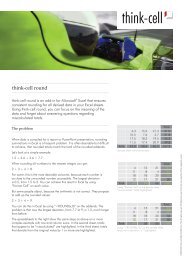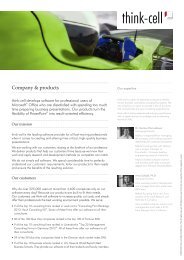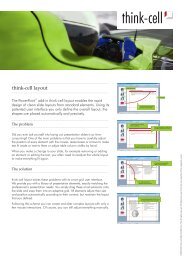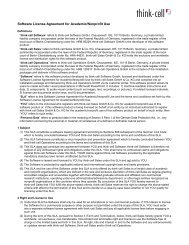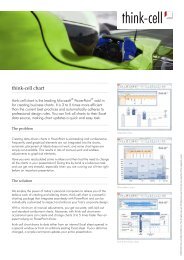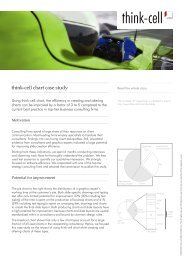think-cell technical report TC2003/01 A GUI-based Interaction ...
think-cell technical report TC2003/01 A GUI-based Interaction ...
think-cell technical report TC2003/01 A GUI-based Interaction ...
Create successful ePaper yourself
Turn your PDF publications into a flip-book with our unique Google optimized e-Paper software.
3.1 User Interfaces for Layout Specification STATE OF THE ART<br />
Principle Refinements<br />
“Maintain visual context” • Display only the labels (no backgrounds)<br />
• Violate geometric layout of pie wedges<br />
• Make labels symmetric<br />
“Hide unnecessary information” • Hide parent menus<br />
“Support skill development using • Use eight menu items<br />
graphical feedback” • Use compass star with menu center<br />
• Show idealized marks<br />
Figure 8: Design refinements on marking menus as suggested by Tapia and Kurtenbach<br />
[TK95] (annotated)<br />
do not cover the visual context of an interaction. Yet, they are easy to learn, because<br />
not drawing a mark, triggers a normal pie menu as a reminder of the menu item<br />
layout. Kurtenbach and Buxton [KB94] studied user learning and performance with<br />
marking menus and concluded that marking menus are a very effective interaction<br />
technique, as long as the list of items does not dynamically change. They suggested<br />
that marking menus would be an appropriate technique for user interaction in many<br />
popular software such as Microsoft Word.<br />
Based on existing implementations of marking menus, Tapia and Kurtenbach<br />
[TK95] suggested some refinements and principles on the appearance and behavior<br />
of marking menus (Fig. 8). Friedlander et al. [FSM98] suggest another variation,<br />
which they call bullseye menu: A bullseye menu is a series of concentric circles<br />
divided into sectors. The effect being, the wedges of the normal pie menu are<br />
further divided so that more menu items can be presented in a single menu.<br />
Other Menu Types<br />
A great deal of research has gone into different ways to enhance traditional menus.<br />
Cornelison [Cor] as well as Sears and Shneiderman [SS94] compared user perfor-<br />
mance for static menus with performance for split menus, which group frequently<br />
used items in a dynamic section of the item list. They found that for specific appli-<br />
cations and user populations split menus perform significantly better. We find this<br />
technique in the Microsoft Windows XP Start menu, where recently used applica-<br />
tions are presented first.<br />
Guimbretière and Winograd [GW00] developed a concept they call FlowMenu,<br />
which effectively is a hierarchical pie menu with submenus shown in the same place<br />
like the parent menu. Multiple stage menu selections can be performed in one<br />
interaction, allowing the use of a non-visible menu similar to marking menus. That<br />
same idea is pursued by Pook et al. [PLVB00] who present what they call control<br />
menus. In this case, a single gesture suffices to select an operation and make a<br />
choice from a continuum of possibilities, such as selecting the zoom option first and<br />
then setting the desired zoom factor.<br />
All menus that have a visual representation have in common that the user must<br />
divide her attention between the context of her work and the menu layout. Harrison<br />
et al. tried to reduce the distraction that stems from visual interference between the<br />
27





